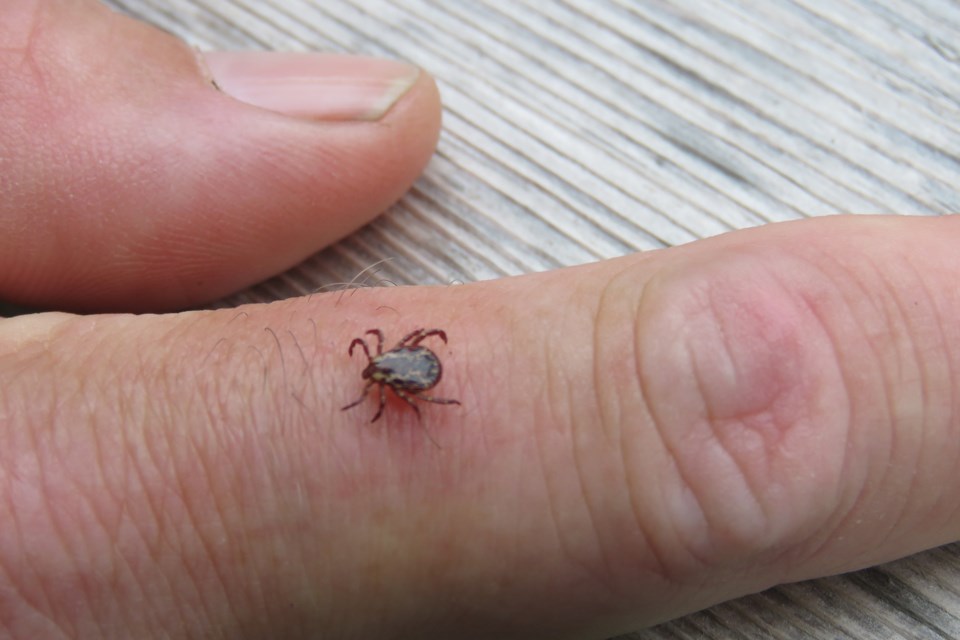Ticks. OMG! Can there be anything ickier to have to deal with in the out of doors?
In my 60-plus years of wandering around most every nook and cranny of the wilds of north Simcoe County I have never laid eyes on a tick... until this year. Now they seem to be 'everywhere'! Yuck!
They have been crawling on my shirt, imbedding in my waist, pulled from my hair, flicked off my pants, and have caused an almost constant creepy-crawly feeling to my skin. I don't like ticks, not even a little bit.
So, what's going on out there? Why so many and what to do about them? And are they really as dangerous to our health as some would have us believe? As with any threat, best first advice is to get to know your enemy, so here goes...
Of the 40 species of ticks in Canada, we seem to be home to just three that are bothersome to us: the wood tick (also known as brown or American dog tick); the black-legged tick (also known as deer tick); and lone-star tick (although this one is very rare in our region, so far).
All MAY carry a hefty list of diseases that COULD cause us humans grief, IF the tick is infected and IF it stays attached to us long enough to transfer the disease. Lyme disease is certainly the one that stands out as a real threat to our personal health.
Ticks have a somewhat complex life cycle, a series of moults and growth stages that involve a blood meal for each step of the way.
The eggs, which are laid on the ground, hatch into very tiny 6-legged larva that crawl around looking for a host to attach themselves to and suck up a bit of blood; this can be a mouse, bird, chipmunk or human. These first stage larva are about the size of a period on a printed page.
Having had a full belly of blood they drop off onto the ground and moult (shed their outer skin) into an 8-legged larva that again seeks out a new host for another blood meal, again being a bird small mammal or human.
Once attached and gleefully tanked up on blood, the engorged tick soon drops to the ground and moults yet again, this time into an adult, either male or female.
These adults now climb up a blade of grass or small shrub, crawl out to the tippy-top, and hold their hooked forelegs out in hopes of snagging a passing dog, human, fox, coyote, deer or moose. This technique is called questing.
So along comes I, out for a quiet walk with my camera to capture the beauty and serenity of nature.
Unnoticed, a dastardly questing tick hooks onto my pant leg and becomes a hitch-hiker. The apple seed-sized critter wastes no time in trying to find a way to get inside to my tender skin, quickly poking around my socks, waist, neck or hair until it can access my glorious blood.
Once in place (favourite places are underarms, groin, back of knees, folds of skin, scalp) they begin drilling into your skin.
Unlike a deerfly bite which hurts like heck you will not feel this, as a painkilling secretion numbs the skin. Once its head is burrowed into the skin a cement-like barrier is formed and the blood sucking begins.
If undetected for a few days (as may be the case with a dog) the female tick engorges with blood until the size of a small grape. She then detaches and falls to the ground, ready to lay eggs.
One female can lay 5,000 eggs! Then she dies (hooray!). The males will mate just before that last stage of engorgement, but they do not require a large blood meal themselves, so a quick snack may be all they want from you.
Actually, they are using your body as a dating place, hoping to bump into a nice lady tick who may be still unattached. (Eww, yuck, skin crawl.)
It is during that blood withdrawal that the transfer of disease takes place. The longer a tick is imbedded the greater the chance of the host getting inoculated if the tick is a carrier of bad stuff.
To minimize tick success we have to do some things to interrupt that complex life cycle. Removing yourself from the list of hosts is the first thing.
Start by not wearing shorts or short-sleeved shirts while walking through tall grass areas. Tuck your pant legs inside your socks. Douse clothing and exposed skim with an insect repellent containing DEET (if you prefer natural remedies, prepare a spray containing lemon, orange, lavender, peppermint and/or cinnamon.)
Conduct a tick check while walking, scanning your light-coloured shirt and pants for new arrivals. Adults can be easily seen but may require a bit of convincing to let go of the fabric, due to their tough curved legs.
After your walk do a body scan for ticks that made their way inside your clothes; use a mirror or a close friend to check the hard-to-see areas.
Remove any imbedded ticks. This can be done with fine-tipped tweezers or a tick removal tool. Do not smear tick with nail polish remover, petroleum jelly or salve... this just makes her angry and she will burrow deeper into your skin.
Check out the website of the Canadian Lyme Disease Foundation (www.canlyme.com) for good info and videos on tick removal. Do not view YouTube videos as some techniques displayed there are actually going to make things worse.
For whatever the reasons, ticks are now a part of our outdoors experience. I've had them hitch onto me from nature reserves to provincial parks to privately-owned back meadows.
They are everywhere, and now we have to be ever watchful. Other than that, enjoy yourselves out there!
